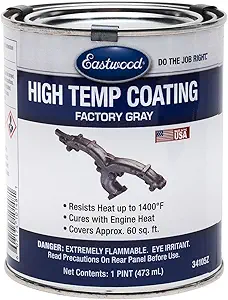Best Engine Bay Paint in 2025 – Ultimate Guide and Top Reviews
If you’re passionate about car maintenance or restoration, you know that the engine bay isn’t just a functional space it’s also a place to showcase your vehicle’s care and attention to detail. A clean, fresh, and well-painted engine bay can dramatically improve your car’s aesthetics and protect critical components from corrosion, heat, and grime.
But not all paints are created equal when it comes to engine bays. You need paint that resists high temperatures, chemical exposure, dirt, and wear while providing a professional finish that lasts. That’s why choosing the best engine bay paint is crucial for any serious car enthusiast or professional mechanic.
We’ll walk you through everything you need to know about engine bay paint in 2025: the key features, types, application tips, and the top-rated products you can trust for your project.
Why Paint Your Engine Bay?
Before diving into the best products, it’s important to understand why painting your engine bay is beneficial:
- Protection from Corrosion: The engine bay is exposed to moisture, oil, grease, and other chemicals that can cause rust. High-quality paint seals and protects metal surfaces.
- Heat Resistance: Engine bays endure extreme temperatures. Specialized paints protect surfaces from heat damage and fading.
- Easy Cleaning: A smooth painted surface resists dirt and grease buildup, making cleaning easier.
- Enhanced Appearance: A freshly painted engine bay looks clean and professional, boosting your vehicle’s value and pride of ownership.
- Customization: Choose colors that match or complement your car for a custom look.
What Makes the Best Engine Bay Paint?
Choosing the right paint for your engine bay involves considering several key factors:
1. High Heat Resistance
Engine bays can reach temperatures over 500°F (260°C). Your paint must tolerate this heat without peeling, blistering, or discoloring.
2. Chemical & Oil Resistance
Paint needs to withstand exposure to oil, grease, brake fluid, and other automotive chemicals commonly found in engine compartments.
3. Durability & Adhesion
Engine bay paint should strongly adhere to metal surfaces and resist chipping or flaking from vibrations, heat cycles, and cleaning.
4. Ease of Application
Depending on your skill level, choose paint that offers straightforward application via spray, brush, or roller. Some paints may require primers or clear coats.
5. Finish and Color Options
Typically, semi-gloss or satin finishes are preferred for engine bays to reduce glare while showcasing a clean look. Black is the most common color, but custom colors are available.
Types of Engine Bay Paints
There are a few different types of paints suitable for engine bays:
1. High-Temperature Engine Enamel
These paints are specially formulated for engine components, offering excellent heat resistance and durability.
2. High-Heat Spray Paint
Designed for parts like headers and exhausts, these paints tolerate high temperatures but are often thinner in coverage.
3. Epoxy-Based Paint
Epoxy paints provide excellent adhesion and chemical resistance but may require more prep work.
4. Urethane Paint
Urethanes offer a hard, durable finish with excellent chemical and abrasion resistance, often used by professionals.
How to Prepare Your Engine Bay for Painting
Proper preparation is essential for the best results:
- Clean Thoroughly: Use degreasers and engine cleaners to remove oil, dirt, and grease.
- Remove Loose Paint and Rust: Sand or wire brush to remove flaking paint and corrosion.
- Mask Off Components: Protect wiring, hoses, and parts you don’t want painted.
- Apply Primer: Use a high-temperature primer for bare metal.
- Paint in Thin Coats: Allow drying between coats for durability.
Top 7 Best Engine Bay Paints in 2025 – Detailed Reviews
| Product | Type | Heat Resistance | Finish | Application | Price Range |
|---|---|---|---|---|---|
| VHT FlameProof Coating | Engine Enamel | Up to 2000°F | Satin | Spray | $$ |
| POR-15 Engine Enamel | Epoxy-Based | Up to 450°F | Gloss | Brush or Spray | $$$ |
| Dupli-Color High Heat | Engine Enamel Spray | Up to 1200°F | Satin | Spray | $ |
| Eastwood High Temperature Coating | Engine Enamel | Up to 1200°F | Satin | Spray | $$ |
| Rust-Oleum High Heat Enamel | High Heat Spray | Up to 1200°F | Satin | Spray | $ |
| SEM High-Temp Coating | Urethane | Up to 1000°F | Satin | Spray or Brush | $$$ |
| Krylon High Heat Spray Paint | High Heat Spray | Up to 1200°F | Satin | Spray | $ |
1. VHT FlameProof Coating

Best Overall Engine Bay Paint
VHT FlameProof is a top choice among car enthusiasts for its outstanding heat resistance and smooth finish. It can withstand up to 2000°F, making it ideal for headers, manifolds, and the entire engine bay.
- Finish: Satin black or custom colors.
- Durability: Resists chipping and fading.
- Application: Spray can or professional spray gun.
- Pros: Extremely heat resistant, easy to apply, quick drying.
- Cons: Requires multiple coats for full coverage.
Why Choose VHT FlameProof?
It offers professional-grade heat protection with a user-friendly application process, perfect for most DIY and professional projects.
2. POR-15 Engine Enamel

Best Epoxy-Based Engine Paint
POR-15 is known for its superior adhesion and corrosion resistance. This epoxy-based enamel resists heat up to 450°F and is great for sealing and painting previously rusted or bare metal surfaces.
- Finish: Gloss black.
- Durability: Exceptional adhesion and chemical resistance.
- Application: Brush or spray.
- Pros: Outstanding rust protection, tough finish.
- Cons: Lower heat tolerance compared to VHT; requires careful application.
Why Choose POR-15?
Ideal if corrosion protection is your priority and you want a durable, glossy finish.
3. Dupli-Color High Heat Spray Paint

Best Budget-Friendly Option
Dupli-Color’s high heat spray paint offers reliable heat resistance up to 1200°F and comes in a convenient aerosol can.
- Finish: Satin.
- Durability: Good for moderate heat zones.
- Application: Spray can, easy for DIY.
- Pros: Affordable, easy to find.
- Cons: Not suitable for extreme heat parts.
Why Choose Dupli-Color?
Great for budget-conscious users tackling typical engine bay areas.
4. Eastwood High Temperature Coating

Best for Durability
Eastwood’s high-temp coating can handle up to 1200°F and is favored for its durability and chemical resistance.
- Finish: Satin black.
- Application: Spray can.
- Pros: Excellent adhesion, durable finish.
- Cons: Limited color options.
Why Choose Eastwood?
A solid choice for serious restorers needing a tough, long-lasting paint.
5. Rust-Oleum High Heat Enamel

Best Widely Available High Heat Paint
Rust-Oleum offers a budget-friendly high heat enamel that withstands up to 1200°F. It’s easy to apply and offers decent durability.
- Finish: Satin black.
- Application: Spray can.
- Pros: Affordable, widely available.
- Cons: May require more frequent recoats.
Why Choose Rust-Oleum?
Perfect for general engine bay refreshes with moderate heat exposure.
6. SEM High-Temp Coating

Best Professional Grade Urethane
SEM High-Temp Coating is a professional-grade urethane paint that resists heat up to 1000°F and provides a hard, chemical-resistant finish.
- Finish: Satin.
- Application: Spray or brush.
- Pros: Hard, durable, excellent chemical resistance.
- Cons: More expensive, requires primer.
Why Choose SEM?
Ideal for professionals or serious DIYers seeking a premium finish.
7. Krylon High Heat Spray Paint

Best for Easy Touch-Ups
Krylon’s high heat spray paint offers a satin finish and heat resistance up to 1200°F at a budget price point.
- Application: Spray can.
- Pros: Easy application, affordable.
- Cons: Less durable than premium options.
Why Choose Krylon?
Quick fixes and minor engine bay touch-ups.
How to Apply Engine Bay Paint: Step-by-Step
- Preparation: Clean engine bay thoroughly with degreasers. Remove rust, old paint, and dirt.
- Masking: Cover parts that shouldn’t be painted (wiring, hoses, etc.).
- Primer: Apply a high-temperature primer if recommended by the paint manufacturer.
- Painting: Spray or brush on thin, even coats. Allow each coat to dry.
- Curing: Let paint fully cure before exposing the engine to heat or fluids.
- Cleanup: Remove masking and clean tools.
9 Frequently Asked Questions
1. Can I use regular spray paint in the engine bay?
No, regular paint lacks heat and chemical resistance, leading to peeling and damage.
2. What temperature should engine bay paint withstand?
At least 500°F; for headers or exhaust, up to 2000°F.
3. How long does engine bay paint last?
With proper prep and quality paint, 3–7 years or more.
4. Do I need to use a primer?
Usually yes, for bare metal or rusted surfaces, to ensure adhesion.
5. Can I paint over old engine paint?
Yes, but surface prep is critical — clean, sand, and degrease.
6. How do I clean a painted engine bay?
Use mild soap, water, and avoid harsh chemicals or pressure washing.
7. How many coats should I apply?
Typically 2-3 thin coats for best coverage and durability.
8. Can I paint hot engine parts?
No, paint must be applied to cool surfaces for proper adhesion.
9. Is it safe to spray paint inside the engine bay?
Yes, with proper ventilation and protective gear, but avoid overspray on sensitive parts.
Final Thoughts – What’s the Best Engine Bay Paint for You?
For most car enthusiasts, VHT FlameProof Coating stands out as the best overall engine bay paint in 2025. Its exceptional heat resistance, ease of use, and durability make it the go-to for professional and DIY projects alike. If corrosion resistance is a priority, POR-15 Engine Enamel is a fantastic option, though it requires careful preparation.
Budget-conscious users can rely on Dupli-Color High Heat Spray Paint or Rust-Oleum High Heat Enamel for solid performance at a lower cost. Remember, proper surface preparation and application technique are just as important as your paint choice. Invest time in prep to get a long-lasting, professional finish that will make your engine bay stand out.
Ready to transform your engine bay? Grab your supplies, follow our tips, and enjoy the satisfaction of a sleek, protected engine compartment!


Leave a Reply